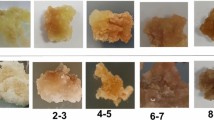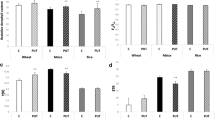Abstract
Growth and production kinetics of three important glycoalkaloids viz. α-solanine, solanidine, and solasodine in two contrasting prickly and prickleless plants of Solanum viarum Dunal were evaluated under in vitro conditions. The prickleless plants showed improved accumulation of total glycoalkaloid content [7.11 and 6.85 mg g−1 dry weight (DW)] and growth (GI = 11.08 and 19.26) after 45 and 50 days of culture cycle, respectively. For higher biomass (91.18 g l−1) as well as glycoalkaloid (52.56 mg l−1) recovery, the prickleless plants served as highly profitable platform. All the three studied glycoalkaloids were identified and quantified by mass spectrometry and HPLC. All the three studied glycoalkaloids accumulated in age-dependent manner. The presence of two constituents, i.e., solasodine and solanidine mainly contributed for higher accumulation of total glycoalkaloid content in the prickleless plants. However, the synthesis of α-solanine was highly age specific and could be detected after 4 to 5 weeks of culture cycle in both prickle containing as well as prickleless plants of S. viarum. The higher accumulation of glycoalkaloids in prickleless plants was also supported with the expression analysis of six key pathway enzymes viz. mevalonate kinase (MVK), 3-hydroxy-3-methyl-glutaryl coenzyme A reductase (HMGR), farnesyl diphosphate synthase (FPS), UDP-galactose/solanidine galactosyltransferase (SGT1), UDP-glucose/solanidine glucosyltransferase (SGT2), and cytochrome P450 monooxygenase (CYP). The results indicated that the plants harvested after 45 and 50 days of culture cycle accumulated maximum bioactive in-demand glycoalkaloids in the prickly and prickleless plants of S. viarum Dunal, respectively.





Similar content being viewed by others
References
Abe I, Rohmer M, Prestwich GD (1993) Enzymatic cyclization of squalene and oxidosqualene to sterols and triterpenes. Chem Rev 93:2189–2206
Alvarez MA (2014) Solasodine production in Solanum eleagnifolium in vitro cultures. In: Plant Biotechnology for Health. Springer, Cham
Bergenstråhle A, Borga P, Jonsson MV (1996) Sterol composition and synthesis in potato tuber discs in relation to glycoalkaloid synthesis. Phytochemistry 41:155–161
Bhatnagar P, Bhatnagar M, Nath AK, Sharma DR (2004) Production of solasodine by Solanum laciniatum using plant tissue culture technique. Ind J Exp Biol 42:1020–1023
Cahill MG, Caprioli G, Vittori S, Jamesa KJ (2010) Elucidation of the mass fragmentation pathways of potato glycoalkaloids and aglycons using Orbitrap mass spectrometry. J Mass Spectrom 45:1019–1025
Cherkaoui S, Bekkouche K, Christen P, Veuthey JL (2001) Non-aqueous capillary electrophoresis with diode array and electrospray mass spectrometric detection for the analysis of selected steroidal alkaloids in plant extracts. J. Chromatogr. A 922:321–328
Dwivedi S, Alam A, Shekhawat GS (2016) Relative production and quantification of stevioside from in-vitro generated shoots, callus, suspension culture and synseeds of Stevia rebaudiana (Bertoni) Bertoni. Plant cell Biotechnol Mol Biol 17:155–166
Eanes RC, Tek N, Kirsoy O, Frary A, Doganlar S, Almeida AE (2008) Development of practical HPLC methods for the separation and determination of eggplant steroidal glycoalkaloids and their aglycones. J Liq Chromatogr Relat Technol 31:984–1000
Gbadamosi IT, Afolayan AJ (2016) In vitro anti-radical activities of extracts of Solanum nigrum (L.) from South Africa. J Appl Biosci 98:9240–9251
Ginzberg I, Tokuhisa JG, Veilleux RE (2009) Potato steroidal glycoalkaloids: biosynthesis and genetic manipulation. Potato Res 52:1–15
Ginzberg I, Thippeswamy M, Fogelman E, Demirel U, Mweetwa AM, Tokuhisa J, Veilleux RE (2012) Induction of potato steroidal glycoalkaloid biosynthetic pathway by overexpression of cDNA encoding primary metabolism HMG-CoA reductase and squalene synthase. Planta 235:1341–1353
Jacob A, Malpathak N (2004) Green hairy root cultures of Solanum khasianum Clarke—a new route to in vitro solasodine production. Curr Sci 87:1442–1447
Jacob A, Malpathak N (2005) Plantlet regeneration enhances solasodine productivity in hairy root cultures of Solanum khasianum Clarke. In Vitro Cell Dev Biol-Plant 41:291–295
Jayakumar K, Murugan K (2016) Solanum alkaloids and their pharmaceutical roles: a review. J Anal Pharm Res 3:75
Khanna KR, Singh SP (1985) Harvesting Solanum viarum Dunal as a spineless crop. Sci culture 51:25
Kittipongpatana N, Hock RS, Porter JR (1998) Production of solasodine by hairy root, callus and cell suspension cultures of Solanum aviculare Forst. Plant Cell Tiss Organ Cult 52:133–143
Laule O, Furholz A, Chang HS, Zhu T, Wang X, Heifetz PB, Gruissem W, Lange BM (2003) Crosstalk between cytosolic and plastidial pathways of isoprenoid biosynthesis in Arabidopsis thaliana. Proc Natl Acad Sci USA 100:6866–6871
Loc NH, Thanh LTH (2011) Solasodine production from cell culture of Solanum hainanense Hance. Biotech Bioprocess Eng 16:581–586
Maiti PC, Mookerjea S, Mathew R (1965) Solasodine from Solanum khasianum. J Pharm Sci 54:1828–1829
Mathur S, Shekhawat GS (2013) Establishment and characterization of Stevia rebaudiana (Bertoni) cell suspension culture: an in vitro approach for production of stevioside. Acta Physiol Plant 35:931–939
Murashige T, Skoog F (1962) A revised medium for rapid growth and bio assays with tobacco tissue cultures. Physiol Plantarum 15:473–497
Ohnishi T, Yokota T, Mizutani M (2009) Insights into the function and evolution of P450s in plant steroid metabolism. Phytochemistry 70:1918–1929
Padmashree A, Sharma GK, Semwal AD, Mahesh C (2014) Antioxygenic activity of Solanum nigrum L. leaves in sun flower oil model system and its thermal stability. Food Nutr Sci 5:1022–1029
Pandey S, Goel R, Bhardwaj A, Asif MH, Sawant SV, Misra P (2018) Transcriptome analysis provides insight into prickle development and its link to defense and secondary metabolism in Solanum viarum Dunal. Sci Rep 8:17092
Patel K, Singh RB, Patel DK (2013) Medicinal significance, pharmacological activities, and analytical aspects of solasodine: a concise report of current scientific literature. J Acute Dis. 2:92–98
Prasad A, Mathur A, Singh M, Gupta MM, Uniyal GC, Lal RK, Mathur AK (2012) Growth and asiaticoside production in multiple shoot cultures of a medicinal herb, Centella asiatica (L.) Urban, under the influence of nutrient manipulations. J Nat Med 66(2):383–387
Putalun W (2011) Technology of compact MAb and its application for medicinal plant breeding named as missile type molecular breeding. Curr Drug Discov Technol 8:24–31
Singh RK, Chaudhary BD (1979) Biometrical methods in quantitative genetic analysis. Kalyani Publishers, New Delhi
Singh S, Khanna K, Sudhir S (1998) Breeding of Solanum viarum: current status as steroid bearing plant. J Med Arom Plant Sci 20:423–431
Srivastava M, Sharma S, Misra P (2016) Elicitation based enhancement of secondary metabolites in Rauwolfia serpentina and Solanum khasianum hairy root cultures. Phcog Mag 12:315–320
Sun Y, Zhao Y, Wang L, Lou H, Cheng A (2012) Cloning and expression analysis of squalene synthase, a key enzyme involved in antifungal steroidal glycoalkaloids biosynthesis from Solanum nigrum. Drug Discov Ther 6:242–248
Tambe NM (2013) Studies on in vitro callus culture of Solanum khasianum Clarke. Inter J Recent Trends Sci Technol 5:111–112
Uddin A, Chaturvedi H (1979) Solasodine in somatic tissue cultures of Solanum khasianum. Planta Med 37:90–92
Umemoto N, Nakayasu M, Ohyama K, Yamashita MY, Mizutani M, Seki H, Saito K, Muranaka T (2016) Two cytochrome P450 monooxygenases catalyze early hydroxylation steps in the potato steroid glycoalkaloid biosynthetic pathway. Plant Physiol 171:2458–2467
Wu XF, Shi HP, Tsang P, Keung E (2008) Induction and in vitro culture of hairy roots of Solanum nigrum L. var. pauciflorum Liou and its solasodine production. J Mol Cell Biol 41:183–191
Wu JJ, Gao R, Shi Y, Tian WS (2015) Facile synthesis of solasodine based on a mild halogenation-ring opening reaction of spiroketals in steroidal sapogenins. Tetrahedron Lett 56:1215–1217
Zelezniak A, Sheridan S, Patil KR (2014) Contribution of network connectivity in determining the relationship between gene expression and metabolite concentration changes. PLOS Comput Biol 10:e1003572
Zha XM, Sun H, Hao J, Zhang Y (2007) Efficient synthesis of solasodine, O-acetylsolasodine, and soladulcidine as anticancer steroidal alkaloids. Chem Biodivers 4:25–31
Zhang GP, Shen SD, Lei M, Hu LH (2011) A facile and efficient method for the synthesis of solasodine from diosgenin. Tetrahedron 67:5894–5896
Zywicki B, Catchpole G, Draper J, Fiehn O (2005) Comparison of rapid liquid chromatography-electrospray ionization-tandem mass spectrometry methods for determination of glycoalkaloids in transgenic field-grown potatoes. Anal Biochem 336:178–186
Acknowledgments
The authors are grateful to Director Council of Scientific and Industrial Research - NBRI, Lucknow for providing the necessary facilities. The senior author AP also acknowledges the award of NPDF with grant no. DST-PDF/2016/000922 to Science and Engineering Research Board, Department of Science and Technology, New Delhi (India).
Author information
Authors and Affiliations
Corresponding author
Ethics declarations
Conflict of interest
The authors declare that they have no conflict of interest.
Additional information
Handling Editor: Peter Nick
Publisher’s note
Springer Nature remains neutral with regard to jurisdictional claims in published maps and institutional affiliations.
Rights and permissions
About this article
Cite this article
Prasad, A., Patel, P., Pandey, S. et al. Growth and alkaloid production along with expression profiles of biosynthetic pathway genes in two contrasting morphotypes of prickly and prickleless Solanum viarum Dunal. Protoplasma 257, 561–572 (2020). https://doi.org/10.1007/s00709-019-01446-3
Received:
Accepted:
Published:
Issue Date:
DOI: https://doi.org/10.1007/s00709-019-01446-3




